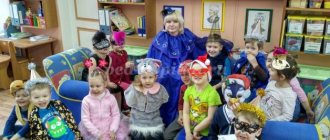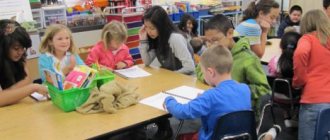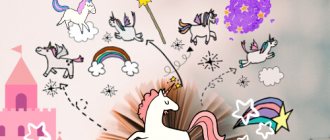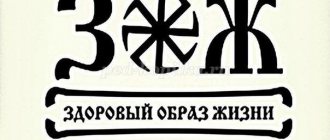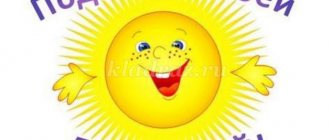Middle group. Junior preschool age. Children 4 - 5 years old
Summary of a lesson on speech development in the middle group “Birds” [Purpose: to summarize children’s knowledge about wintering birds. Objectives: -clarify and expand children’s ideas about wintering birds; - learn to distinguish between domestic and wild birds; -clarify children’s ideas about what birds eat in winter; -develop speech, attention, memory, thinking; -bring up…
Summary of GCD in the middle group with a presentation “The World of Fairy Tales” Synopsis of GCD in the middle group with a presentation on the topic “World of Fairy Tales”
.
This summary of educational activities in the educational areas “Speech Development”
and
“Cognitive Development”
in the middle group with TRIZ elements.
Topic “Journey to the world of fairy tales”
Author: Yulia Vasilievna Krekoten, teacher…
Summary of an open comprehensive lesson in kindergarten (middle group)
Summary of an open comprehensive lesson in kindergarten (middle group)
Program tasks
Exercise children in counting within 10. Test their knowledge of the first ten numbers. Develop an understanding of geometric bodies (ball, cube, cylinder, cone). Strengthen children's ability to draw using non-traditional methods (cotton swabs, cork impressions). Learn on your own, create a pattern.
Activate children's mental activity, develop logical thinking and intelligence. Learn to foster joint discussion, search for and find an answer. Develop the ability to quickly get involved in the active preparatory process. Develop analytical perception, sustained attention, memory, speech. Learn to take a creative and proactive approach to solving problems. Develop aesthetic perception and imagination. Create surprise and novelty in the environment.
Materials
Part I:
- Magic wand.
- Whatman paper and markers.
- 2 colored paper wheels for the car.
- Driver's steering wheel.
- A clearing with flowers, there are riddles on the flower petals.
- 3 hoops and geometric bodies (Cube, ball, cone, pyramid, cylinder).
- Audio recordings: a) children's song: “We are going, going, going...”; b) “Russian folk melodies”.
Part II:
- Screen, doll. (Ivan Tsarevich)
- Planar image of the “Firebird”.
- Feather samples with pattern elements (3 pieces).
- Gouache in three colors (orange, red, crimson).
- Cotton buds. Corks, brush “Squirrel” No. 2.
- Napkins for drawing.
- Jars of water.
- Brush holders.
- Sockets with foam insert, impregnated with gouache.
- Sheets of yellow paper in the shape of bird feathers.
PROGRESS OF THE CLASS
The day before the group received an invitation from Ivan Tsarevich.
Educator:
Children, we have received an invitation from Tsarevich Ivan. Let's go to him.
Educator
: Look, guys!
There's a strange map here. It only shows dots, if we can connect the dots with lines in order, then we will understand something .
(Children connect the dots to create an image of a car)
Picture 1
Educator:
We'll hit the road by car! Let's choose a driver using a little counting rhyme:
(Children count and choose a driver)
Educator:
Go!
(Music “We’re going, we’re going, we’re going”…)
Educator:
Children, where have we ended up? Who will tell us?
Voice:
You have reached the lawn of “Riddles”. I am the owner of this lawn. You must guess all the riddles on my flowers. Only then will you be able to go to Ivan Tsarevich.
(Children find riddles on the petals)
On a red flower:
- The elephant is big, and the mouse...
- The pillow is soft, and the table...
- The tree is tall. And the grass...
- The river is wide, and the stream...
- Ice is cold and fire...
- The floor is below and the ceiling...
On a yellow flower:
- Say a sweet word.
- Fast.
- Word with a window.
- Fluffy.
- Sour.
- Lesnoye.
Lawn owner:
Well done! Now try to guess my riddles. What word did I have in mind?
- White spins and falls to the ground...
- Brown, club-footed, clumsy...
- Small, gray, timid, lives in a hole...
- Sweet, tasty in a wrapper...
Educator:
Now, our children will try to tell you a riddle, and you try to guess it.
(Children come up with and make riddles themselves, the owner of the lawn must guess them)
Lawn owner:
You completed the task well, you can move on!
(Children get into the car and drive on, music sounds)
Educator:
Children, we are probably in the wrong place again, Tsarevich Ivan is not here.
Voice:
You have found yourself in a clearing of geometric bodies. I am the boss here, and you must cope with my tasks.
Game description:
Each geometric body must fall into a hoop of the corresponding color, where the hoops intersect there may be bodies of two colors.
Game: “Find a place for a geometric body”
Figure 2
The owner of the clearing:
Well done, children! We completed my assignments. Now you can go to Ivan Tsarevich! Bon Voyage.
Educator:
So we got to Ivan Tsarevich!
(Showing a doll from behind a screen, sad)
Educator:
Children, here he is. He's not funny at all. Let's ask him what happened.
What, Ivanushka is not cheerful, what, has he hung his head?
Ivan Tsarevich:
I stopped eating and sleeping. I wish I could get the firebird. That bird lost a feather when it flew in our garden. Pen, I picked this up, Since then I have lost peace. I had already worn out all my shoes, but I couldn’t find the Firebird.
Educator:
Don’t worry, Ivanushka, trouble is no big deal! You, my friend, ended up in kindergarten and you are visiting the guys. Vanya, we’ll help you, it’s no good for you to grieve.
Educator:
The guys and I saw this bird in a fairy-tale kingdom-state, and there it is! Look Ivanushka, isn't it her you're looking for?
(The teacher shows a bird that has no feathers on its tail)
Ivan Tsarevich:
No, this bird is not mine. Mine had a bright, beautiful tail.
Educator:
And this is not a problem. Our children will help you.
Guys, look at the table in front of you one feather at a time, we will decorate them with various patterns, and then from all the feathers we will assemble a beautiful, bright tail for the Firebird.
(Go to your seats, sit down)
On your tables are: corks, brushes and cotton swabs. You already know and can draw wonderfully with them. Think about which tool you will need to work with first and which later, and what color you want to leave on the feathers. If you take the corks, you might end up with a pattern like this. Then you take a cotton swab and your pattern will change. Then you take a brush and complete your design. I got this feather.
Figure 3
(Children draw, music plays, the teacher corrects the children’s actions)
Educator:
What kind of feathers did you get? Let's look at them! Now we will decorate the tail of the Firebird with your elegant feathers.
(As the children finish their work, each child comes up and puts a feather to his tail, the teacher positively evaluates the work of each child)
Educator:
Ivanushka, look what our children have accomplished! Do you like Firebird?
Ivan Tsarevich:
Thank you for being friendly, what a bird they got me. She will not live in a cage, but sit on a branch in the garden. He will sing songs and decorate the magical garden.
Educator:
That’s good, Ivan Tsarevich, we helped you. It's time for us to return to kindergarten. Goodbye, Ivan Tsarevich!
Figure 4
Forms of organizing joint activities
| Children's activities | Forms and methods of organizing joint activities |
| Motor | 1. Outdoor game “Harvesting”. 2. Articulation gymnastics. |
| Gaming | Didactic game “Gifts from Dunno - a bag of fruits.” |
| Productive | Album design - paste pictures of fruits. |
| Cognitive and research | Solving a problem situation (how to grow a square watermelon), experience. |
| Communicative | Questions, speech situations. |
| Perception of fiction | Listening to (and guessing) poetic riddles. |
Summary of direct educational activities in the middle group of kindergarten.
Summary of direct educational activities in the middle group of kindergarten.
Indoor plants in a kindergarten are not only a piece of furniture, but also a means of air purification, a means of “acquaintance” and communication between children and nature. we are so accustomed to flowers on the windowsill that they have become part of our life, a life that is bright, green, fluffy and glossy, but always bringing joy. Target
: Remember the names of indoor plants, their parts and actions for caring for plants (watering, loosening the soil, wiping or spraying leaves).
Objectives:
Educational.
Instill an interest in indoor plants and a desire to care for them. Cultivate a positive attitude towards nature, a love of work, in order to enjoy work. Educational. Exercise children to speak in complete sentences, coordinating adjectives with nouns. Developmental. Develop aesthetic taste, the ability to receive positive emotions from the sight and contact with indoor plants. Develop the ability to describe an object, highlighting its parts and characteristic features. Materials Indoor flowers in pots, pictures of indoor plants, a cube with indoor plants depicted on its sides. Preliminary work. Daily care for indoor plants, observing them. Introducing indoor plants in previous sessions on the topic “Getting to know indoor plants.” Children become familiar with the names of plants, their parts, and techniques for caring for indoor plants. The course of the educational activity itself:
(Children sit at the tables in their places).
- Guys, would you like to go on a trip? (Children's answers) - Great, I also want to travel. We just need to think about where we should go? Tell me, where would you like to go on a trip and why? (Children's answers). -Wonderful, any trip is fraught with a lot of new and interesting things. When a person goes on a trip, he thinks, what interesting and memorable things will I see? Many of you have traveled: flown to different countries, traveled to big and small cities. Today, I I suggest you take a trip to the “City of Flowers”. Let's go? (Children line up in a circle). -Now, guys, close your eyes, and I will cast a magic spell that will help us find ourselves in the magical “City of Flowers.” (I read the spell, and at this time I put pots with indoor plants and pictures of indoor plants on the table. (You can turn on an audio recording of nature, birdsong). Spell.
In our group, on the window, on the green side, in painted pots, flowers have grown. Open your eyes and see a fairy tale. -Guys, open your eyes. Look how beautiful it is around. Tell me, what changes did you see? (Children's answers). - Absolutely right, we ended up in the magical “City of Flowers”, that’s why we have so many of them .Tell me, what names of indoor plants do you know? (Children's answers). -Well done, guys, you know a lot of names. Let's play with you.
Game with a cube:
Children stand in a circle. In turn, each child throws a cube and talks about that home the plant that falls out on the top edge of the cube. The teacher starts first and the children continue following his example. The name of the plant is said, what parts of the plant are, what is the height of the stem, what is the shape of the leaves, does it bloom, how to care for the plants and what benefits they bring to people. If a child finds it difficult to answer, we help him with leading questions. If the plant is flowering, the game develops in the other direction: for example, the violet has pink flowers. The teacher invites the children to look at the other children and say who has pink on their clothes. -Well done, guys, let's speak in complete sentences. Listen to me tell the story, and then you will tell it. I describe the clothes of a child who has pink on his clothes, then I invite several children to describe the clothes of other children. -Guys, we had fun playing, listened to stories about many indoor plants, but didn’t talk about how to care for them. Who can tell us about caring for indoor plants? Who has indoor plants at home and who cares for them? (Children's answers). - Well done, guys, they said everything correctly, that the flowers need to be watered, the soil needs to be loosened so that the roots can breathe, the leaves of some plants can be wiped or sprinkled. With our work we extend the life of the plants, they will grow for a long time and bloom beautifully, delighting us and our friends with his appearance. guys, tell me, when you look at indoor plants, does your mood lift, do you feel happy or sad? (Children's answers). - Of course, the sight of indoor plants lifts our spirits, and plants also bring benefits to people: for example, aloe juice can treat wounds and burns, and the juice can be dropped into the nose and there will be no runny nose. But children cannot treat themselves, this is a must Only parents do it, the plant allows treatment only to an adult. You don’t know how yet and can damage the plant, causing it to dry out. Therefore, just tell your parents about the beneficial properties of aloe so that they also know. Well done today, the trip was a success, but you and I need to return to the group. (Children line up in a circle, close their eyes, read a spell, open our eyes and children sit down). - Well, guys, we have returned from a trip, and so that we have a memory of it, I suggest that in your free time you draw the indoor plants that you liked the most.
(To the music, children draw indoor plants. When finished, we look at the drawings and guess whose drawing it is and what plant is depicted on it).
